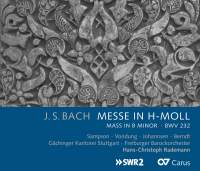Texte paru dans: / Appeared in: |
||||
|
Outil de traduction ~ (Très approximatif) |
||||
|
Reviewer: George
Chien When Johann Sebastian Bach died in 1750 his great Mass in B Minor was complete, but it wasn’t, as we might say now, finalized. Owing to poor health he hadn’t completed the process of editing his manuscript, so he did not leave a definitive score. Of course, there might never have been such a thing. Given his penchant for tinkering with his existing compositions, and with no prospect of a performance or publication in sight, Bach, had he lived longer, might have continued making adjustments and enhancements to the end of his days. After his death the manuscript was entrusted to his son Carl Philipp Emanuel, who made some corrections but was not tempted to “improve” it. That manuscript has been the basis for most performances to date. The B-Minor Mass was an expansion of a Missa (Kyrie and Gloria) that Bach submitted to the Dresden court in 1733. After finding some differences between the C. P. E. Bach manuscript and the parts for the 1733 Missa, Ulrich Leisinger prepared new edition of the Mass, based on Dresden version, for Carus. The Carus edition was used for this recording. The differences, in the Domine Deus and the Quoniam, are relatively minor. My guess is they are not likely to startle most listeners, but they were a reasonable justification for making this recording, not that it needed one. Hans-Christoph Rademann leads a fine performance, well worth your time and attention. He begins with a solemn and stately Kyrie, reminiscent of many older interpretations, but he soon adopts the brisker pace favored by present-day conductors. His Cum Sancto Spirito is as frenetic as any I can remember. The transition from Crucifixus to Et resurrexit is explosive. Much of Rademann’s performance evokes a pervasive sense of the dance—it’s got that swing that really does mean some thing! A grand Dona Nobis Pacem brings the Mass to a noble conclusion. That is, if you stop the disc before it plays the bonus tracks. The manuscript versions of Domine Deus and Quoniam, along with Bach’s 1724 Sanctus and Pleni Sunt Coeli, also borrowed for the great Mass, are appended for comparisons. It’s educational, for sure, but it does break the mood. The Gächinger Kantorei Stuttgart, Helmuth Rilling’s favorite chorus, is well steeped in the idiom. About 30 strong, it sings just as admirably for Maestro Rademann. The Freiburger Barockorchester, one of our premier period instruments ensembles, is equally splendid. Rademann’s solo quartet is a strong one, too, making this a desirable entry in the B-Minor Mass sweepstakes and well recommended. In the days when vinyl was king, you could insert a dead stop between bands to isolate well-intentioned but distracting appendices. With my less-than-state-of-the-art-CD player it’s not so simple. Too bad. | ||||
|
||||
|
|
|
|||
|
Cliquez l'un ou l'autre
bouton pour découvrir bien d'autres critiques de CD |
||||




